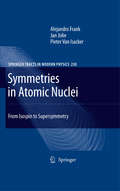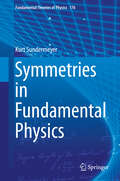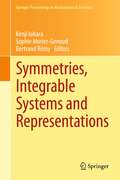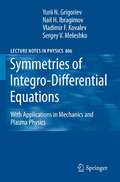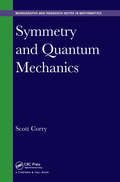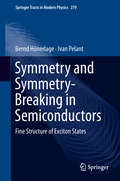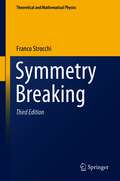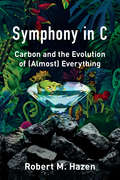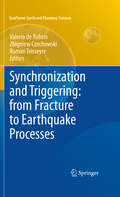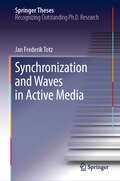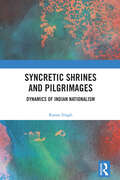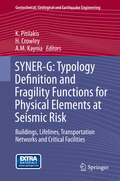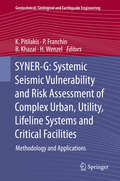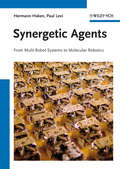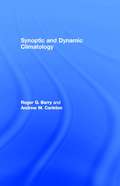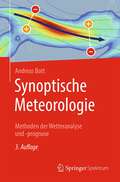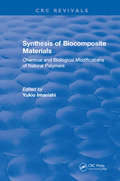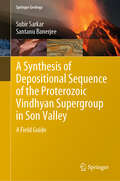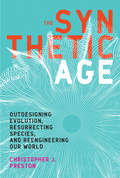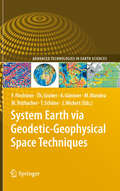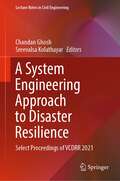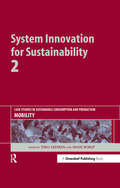- Table View
- List View
Symmetries in Atomic Nuclei
by Pieter Van Isacker Jan Jolie Alejandro FrankSymmetries in Atomic Nuclei aims to present an overview of recent applications of symmetry to the description of atomic nuclei. Special care is given to a pedagogical introduction of symmetry concepts using simple examples. After a historical overview of the applications of symmetry in nuclear physics, progress in the field during the last decade is reviewed. Special emphasis is put on the introduction of neutron-proton and boson-fermion degrees of freedom. Their combination leads to a supersymmetric description of pairs and quartets of nuclei. Both theoretical aspects and experimental signatures of dynamical (super)symmetries are carefully discussed. Case studies show how these symmetries are displayed by real atomic nuclei which have been studied experimentally using state-of-the art spectroscopy. This book focuses on nuclear structure physics and has been written by active investigators in the field, but its scope is wider and is intended for final-year or post-graduate students and researchers interested in understanding the power and beauty of symmetry methods in physics.
Symmetries in Fundamental Physics (Fundamental Theories of Physics #176)
by Kurt SundermeyerOver the course of the last century it has become clear that both elementary particle physics and relativity theories are based on the notion of symmetries. These symmetries become manifest in that the "laws of nature" are invariant under spacetime transformations and/or gauge transformations. The consequences of these symmetries were analyzed as early as in 1918 by Emmy Noether on the level of action functionals. Her work did not receive due recognition for nearly half a century, but can today be understood as a recurring theme in classical mechanics, electrodynamics and special relativity, Yang-Mills type quantum field theories, and in general relativity. As a matter of fact, as shown in this monograph, many aspects of physics can be derived solely from symmetry considerations. This substantiates the statement of E.P.Wigner "... if we knew all the laws of nature, or the ultimate Law of nature, the invariance properties of these laws would not furnish us new information." Thanks to Wigner we now also understand the implications of quantum physics and symmetry considerations: Poincare invariance dictates both the characteristic properties of particles (mass, spin, ...) and the wave equations of spin 0, 1/2, 1, ... objects. Further, the work of C.N.Yang and R.Mills reveals the consequences of internal symmetries as exemplified in the symmetry group of elementary particle physics. Given this pivotal role of symmetries it is thus not surprising that current research in fundamental physics is to a great degree motivated and inspired by considerations of symmetry.The treatment of symmetries in this monograph ranges from classical physics to now well-established theories of fundamental interactions, to the latest research on unified theories and quantum gravity.
Symmetries, Integrable Systems and Representations
by Sophie Morier-Genoud Kenji Iohara Bertrand RémyThis volume is the result of two international workshops; Infinite Analysis 11 - Frontier of Integrability - held at University of Tokyo, Japan in July 25th to 29th, 2011, and Symmetries, Integrable Systems and Representations held at Université Claude Bernard Lyon 1, France in December 13th to 16th, 2011. Included are research articles based on the talks presented at the workshops, latest results obtained thereafter, and some review articles. The subjects discussed range across diverse areas such as algebraic geometry, combinatorics, differential equations, integrable systems, representation theory, solvable lattice models and special functions. Through these topics, the reader will find some recent developments in the field of mathematical physics and their interactions with several other domains.
Symmetries of Integro-Differential Equations: With Applications in Mechanics and Plasma Physics
by N. Kh. Ibragimov Sergey V. Meleshko Yurii N. Grigoriev Vladimir F. KovalevThis book aims to coherently present applications of group analysis to integro-differential equations in an accessible way. The book will be useful to both physicists and mathematicians interested in general methods to investigate nonlinear problems using symmetries. Differential and integro-differential equations, especially nonlinear, present the most effective way for describing complex processes. Therefore, methods to obtain exact solutions of differential equations play an important role in physics, applied mathematics and mechanics. This book provides an easy to follow, but comprehensive, description of the application of group analysis to integro-differential equations. The book is primarily designed to present both fundamental theoretical and algorithmic aspects of these methods. It introduces new applications and extensions of the group analysis method. The authors have designed a flexible text for postgraduate courses spanning a variety of topics.
Symmetry and Quantum Mechanics (Chapman & Hall/CRC Monographs and Research Notes in Mathematics)
by Scott CorryStructured as a dialogue between a mathematician and a physicist, Symmetry and Quantum Mechanics unites the mathematical topics of this field into a compelling and physically-motivated narrative that focuses on the central role of symmetry. Aimed at advanced undergraduate and beginning graduate students in mathematics with only a minimal background in physics, this title is also useful to physicists seeking a mathematical introduction to the subject. Part I focuses on spin, and covers such topics as Lie groups and algebras, while part II offers an account of position and momentum in the context of the representation theory of the Heisenberg group, along the way providing an informal discussion of fundamental concepts from analysis such as self-adjoint operators on Hilbert space and the Stone-von Neumann Theorem. Mathematical theory is applied to physical examples such as spin-precession in a magnetic field, the harmonic oscillator, the infinite spherical well, and the hydrogen atom.
Symmetry and Symmetry-Breaking in Semiconductors: Fine Structure of Exciton States (Springer Tracts in Modern Physics #279)
by Bernd Hönerlage Ivan PelantThis book discusses group theory investigations of zincblende and wurtzite semiconductors under symmetry-breaking conditions. The text presents the group theory elements required to develop a multitude of symmetry-breaking problems, giving scientists a fast track to bypass the need for recalculating electronic states. The text is not only a valuable resource for speeding up calculations but also illustrates the construction of effective Hamiltonians for a chosen set of electronic states in crystalline semiconductors. Since Hamiltonians have to be invariant under the transformations of the point group, the crystal symmetry determines the multiplet structure of these states in the presence of spin-orbit, crystal-field, or exchange interactions. Symmetry-breaking leads to additional coupling of the states, resulting in shifts and/or splittings of the multiplets. Such interactions may be intrinsic, as in the case of the quasi-particle dispersion, or extrinsic, induced by magnetic, electric, or strain fields. Using a power expansion of the perturbations these interaction terms can be determined in their parameterized form in a unique way. The hierarchic structure of this invariant development allows to estimate the importance of particular symmetry-breaking effects in the Hamiltonian. A number of selected experimental curves are included to illustrate the symmetry-based discussions, which are especially important in optical spectroscopy. This text is written for graduate students and researchers who want to understand and simulate experimental findings reflecting the fine structure of electronic or excitonic states in crystalline semiconductors.
Symmetry Breaking: A Non-perturbative Outlook (Theoretical and Mathematical Physics #732)
by Franco StrocchiThe third edition of the by now classic reference on rigorous analysis of symmetry breaking in both classical and quantum field theories adds new topics of relevance, in particular the effect of dynamical Coulomb delocalization, by which boundary conditions give rise to volume effects and to energy/mass gap in the Goldstone spectrum (plasmon spectrum, Anderson superconductivity, Higgs phenomenon). The book closes with a discussion of the physical meaning of global and local gauge symmetries and their breaking, with attention to the effect of gauge group topology in QCD. From the reviews of the first edition: It is remarkable to see how much material can actually be presented in a rigorous way (incidentally, many of the results presented are due to Strocchi himself), yet this is largely ignored, the original heuristic derivations being, as a rule, more popular. - At each step he strongly emphasizes the physical meaning and motivation of the various notions introduced [...] a book that fills a conspicuous gap in the literature, and does it rather well. It could also be a good basis for a graduate course in mathematical physics. J.-P. Antoine, Physicalia 28/2, 2006 Despite many accounts in popular textbooks and a widespread belief, the phenomenon is rather subtle, requires an infinite set of degrees of freedom and an advanced mathematical setting of the system under investigation. [...] The mathematically oriented graduate student will certainly benefit from this thorough, rigorous and detailed investigation. G. Roepstorff, Zentralblatt MATH, Vol. 1075, 2006 From the reviews of the second edition: This second edition of Strocchi’s Symmetry Breaking presents a complete, generalized and highly rigorous discussion of the subject, based on a formal analysis of conditions necessary for the mechanism of spontaneous symmetry breaking to occur in classical systems, as well as in quantum systems. […] This book is specifically recommended for mathematical physicists interested in a deeper and rigorous understanding of the subject, and it should be mandatory for researchers studying the mechanism of spontaneous symmetry breaking. S. Hajjawi, Mathematical Reviews, 2008
Symphony in C (Almost) Everything: Carbon And The Evolution Of (almost) Everything
by Robert M. HazenAn enchanting biography of the most resonant—and most necessary—chemical element on Earth. Carbon is everywhere: in the paper of this book and the blood of our bodies. It’s with us from beginning to end, present in our baby clothes and coffin alike. We live on a carbon planet, and we are carbon life. No other element is so central to our well-being; yet, when missing or misaligned, carbon atoms can also bring about disease and even death. At once ubiquitous and mysterious, carbon holds the answers to some of humanity’s biggest questions. Where did Earth come from? What will ultimately become of it—and of us? With poetic storytelling, earth scientist Robert M. Hazen explores the universe to discover the past, present, and future of life’s most essential element. We’re not only “made of star stuff,” as Carl Sagan famously observed, but “Big Bang stuff,” too. Hazen reveals that carbon’s grand symphony began with a frenzied prelude shortly after the dawn of creation, bringing new attention to the tiny number of Big Bang–created carbon atoms that often get overlooked. In minutes, violently colliding protons and neutrons improbably formed the first carbon atoms, which can still be found within our bodies. His book then unfolds in four movements, building momentum as he explores carbon as the element of Earth, Air, Fire, and Water. He visits the famed volcanic crater Solfatara di Pozzuoli near Naples, where venting carbon dioxide and other noxious fumes condense into beautiful crystals. He climbs the cliffs of the Scottish Highlands and delves deep into the precious-metal mines of Namibia, journeying toward Earth’s mysterious core in search of undocumented carbon structures. Hazen often asks us to pause and consider carbon’s role in climate change and what we can do about it, for our lives and this element are inextricably intertwined. With prose that sparkles like a diamond, Symphony in C tells the story of carbon, in which we all have a part.
Synchronization and Triggering: from Fracture to Earthquake Processes
by Roman Teisseyre Valerio De Rubeis Zbigniew CzechowskiThis monograph contains experimental and theoretical considerations on synchronization and triggering in laboratory fracture experiments and in earthquake processes. Non-linear dynamics and the physics of rotational motions reveal such ordering in geophysical processes and observed time series. Presented experiments with electromagnetic and mechanical forcing show synchronization of the slip instabilities observed as acoustic burst emissions. New observational results, based on a net of broadband seismic stations, indicate the hidden periodicities and multiple coherence effects in the low frequency microseismic oscillations observed tens of hours before the earthquakes. These results are supported by observational evidence on synchronization between shear oscillations and rotation motions in microseismic fields before earthquakes occur.
Synchronization and Waves in Active Media (Springer Theses)
by Jan Frederik TotzThe interplay between synchronization and spatio-temporal pattern formation is central for a broad variety of phenomena in nature, such as the coordinated contraction of heart tissue, associative memory and learning in neural networks, and pathological synchronization during Parkinson disease or epilepsy. In this thesis, three open puzzles of fundametal research in Nonlinear Dynamics are tackled: How does spatial confinement affect the dynamics of three-dimensional vortex rings? What role do permutation symmetries play in the spreading of excitation waves on networks? Does the spiral wave chimera state really exist?All investigations combine a theoretical approach and experimental verification, which exploit an oscillatory chemical reaction. A novel experimental setup is developed that allows for studying networks with N > 1000 neuromorphic relaxation oscillators. It facilitates the free choice of network topology, coupling function as well as its strength, range and time delay, which can even be chosen as time-dependent. These experimental capabilities open the door to a broad range of future experimental inquiries into pattern formation and synchronization on large networks, which were previously out of reach.
Syncretic Shrines and Pilgrimages: Dynamics of Indian Nationalism
by Karan SinghThis book looks at various syncretic traditions in India, such as Bhakti, Nath Yogi, Sufi, Imam Shahi, Ismailis, Khojas and others, and presents an elaborate picture of a redefined cultural space through them. It also investigates different syncretisms - Hindu-Muslim, Hindu-Muslim-Christian and Aboriginal-Ethnic - to understand diverse aspects of hybridity within the Indian nation space. It discusses how Indian nationalism was composed of different opinions from its inception, reflecting its rich diversity and pluralistic traditions. The book traces the emergence of multiple contours of Indian nationalism through the historical trajectory of religious diversity, lingering effects of colonialism, and experimentation with secularism. This volume caters to scholars and students interested in cultural studies, religion studies, pilgrimage studies, history, social anthropology, historical sociology, historical geography, religion and art history. It will also be of interest to political theorists and general readers.
SYNER-G: Typology Definition and Fragility Functions for Physical Elements at Seismic Risk
by K. Pitilakis H. Crowley A. M. KayniaFragility functions constitute an emerging tool for the probabilistic seismic risk assessment of buildings, infrastructures and lifeline systems. The work presented in this book is a partial product of a European Union funded research project SYNER-G (FP7 Theme 6: Environment) where existing knowledge has been reviewed in order to extract the most appropriate fragility functions for the vulnerability analysis and loss estimation of the majority of structures and civil works exposed to earthquake hazard. Results of other relevant European projects and international initiatives are also incorporated in the book. In several cases new fragility and vulnerability functions have been developed in order to better represent the specific characteristics of European elements at risk. Several European and non-European institutes and Universities collaborated efficiently to capitalize upon existing knowledge. State-of-the-art methods are described, existing fragility curves are reviewed and, where necessary, new ones are proposed for buildings, lifelines, transportation infrastructures as well as for utilities and critical facilities. Taxonomy and typology definitions are synthesized and the treatment of related uncertainties is discussed. A fragility function manager tool and fragility functions in electronic form are provided on extras. springer. com. Audience The book aims to be a standard reference on the fragility functions to be used for the seismic vulnerability and probabilistic risk assessment of the most important elements at risk. It is of particular interest to earthquake engineers, scientists and researchers working in the field of earthquake risk assessment, as well as the insurance industry, civil protection and emergency management agencies.
SYNER-G: Systemic Seismic Vulnerability and Risk Assessment of Complex Urban, Utility, Lifeline Systems and Critical Facilities
by K. Pitilakis P. Franchin B. Khazai H. WenzelSYNER-G, a multidisciplinary effort funded by the European Union, allowed the development of an innovative methodological framework for the assessment of physical as well as socio-economic seismic vulnerability and risk at urban and regional level. The results of SYNER-G are presented in two books both published by Springer, the present and a second one, entitled "SYNER-G: Typology Definition and Fragility Functions for Physical Elements at Seismic Risk: Buildings, Lifelines, Transportation Networks and Critical Facilities"(*), which provides a comprehensive state-of-the-art of the fragility curves, an alternative way to express physical vulnerability of elements at risk. In this second volume of SYNER-G, the focus has been on presenting a unified holistic methodology for assessing vulnerability at systems level considering interactions between elements at risk (physical and non-physical) and between different systems. The proposed methodology and tool encompasses in an integrated fashion all aspects in the chain, from hazard to the vulnerability assessment of components and systems and to the socio-economic impacts of an earthquake, accounting for most relevant uncertainties within an efficient quantitative simulation scheme. It systematically integrates the most advanced fragility functions to assess the vulnerability of physical assets for buildings, utility systems, transportation networks and complex infrastructures such as harbours and hospitals. The increasing impact due to interactions between different components and systems is treated in a comprehensive way, providing specifications for each network and infrastructure. The proposed socio-economic model integrates social vulnerability into the physical systems modelling approaches providing to decision makers with a dynamic platform to capture post disaster emergency issues like shelter demand and health impact decisions Application examples at city and regional scale have provided the necessary validation of the methodology and are also included in the book. The present volume, with its companion volume on fragility functions, represent a significant step forward in the seismic vulnerability and risk assessment of complex interacting urban and regional systems and infrastructures. These volumes are not only of interest to scientists and engineers but also to the insurance industry, decision makers and practitioners in the sector of civil protection and seismic risk management. (*) Pitilakis K, Crowley E, Kaynia A (eds) (2014) SYNER-G: Typology definition and fragility functions for physical elements at seismic risk, Series: Geotechnical, Geological and Earthquake Engineering 27, ISBN 978-94-007-7872-6, Springer Science+Business Media, Dordrecht.
Synergetic Agents: From Multi-Robot Systems to Molecular Robotics
by Hermann Haken Paul LeviThis book addresses both multi robot systems and miniaturization to the nanoscale from a unifying point of view, but without leaving aside typical particularities of either. The unifying aspect is based on the concept of information minimization whose precise formulation is the Haken-Levi-principle. The authors introduce basic concepts of multi-component self-organizing systems such as order parameters (well known from equilibrium and non-equilibrium phase transitions) and the slaving principle (which establishes a link to dynamical systems). Among explicit examples is the docking manoeuvre of two robots in two and three dimensions. The second part of the book deals with the rather recently arising field of molecular robotics. It is particularly here where nature has become a highly influential teacher for the construction of robots. In living biological cells astounding phenomena occur: there are molecules (proteins) that literally walk on polymer strands and transport loads that are heavier than their carriers, or molecules that, by joint action, contract muscles. The book provides the reader with an insight into these phenomena, especially by a detailed theoretical treatment of the molecular mechanism of muscle contraction. At the molecular level, for an appropriate approach the use of quantum theory is indispensable. The authors introduce and use it in a form that avoids all the clumsy calculations of wave-functions. They present a model which is based on an elementary version of quantum field theory and allows taking into account the impact of the surrounding on the quantum mechanical activity of a single molecule. By presenting explicit and pedagogical examples, the reader gets acquainted with the appropriate modelling of the walking behaviour of single molecular robots and their collective behaviour. The further development of multi-robot systems and particularly of molecular robots will require the cooperation of a variety of disciplines. Therefore the book appeals to a wide audience including researchers, instructors, and advanced graduate students.
Synoptic and Dynamic Climatology
by Roger G. Barry Andrew M. CarletonSynoptic and Dynamic Climatology provides the first comprehensive account of the dynamical behaviour and mechanisms of the global climate system and its components, together with a modern survey of synoptic-scale weather systems in the tropics and extratropics, and of the methods and applications of synoptic climate classification. It is unrivalled in the scope and detail of its contents. The work is thoroughly up to date, with extensive bibliographies by chapter. It is illustrated with nearly 300 figures and plates.*Part 1 provides an introduction to the global climate system and the space-time scales of weather and climate processes, followed by a chapter on climate data and their analysis*Part 2 describes and explains the characteristics of the general circulation of the global atmosphere and includes the nature and causes of global teleconnection patterns*Part 3 discusses synoptic weather systems in the extratropics and tropics and satellite-based climatologies of synoptic features. It also describes the applications of synoptic climatology and summarises current climatic research and its directions.
Synoptische Meteorologie: Methoden der Wetteranalyse und -prognose
by Andreas BottDas vorliegende Buch beschäftigt sich mit der synoptischen Meteorologie mittlerer Breiten im europäischen Raum. Hierbei wird versucht, die in der angewandten synoptischen Meteorologie interessanten Fragestellungen mit Hilfe der Erkenntnisse aus der theoretischen Meteorologie zu erklären und auf diese Weise eine Verbindung zwischen theoretischer und angewandter Meteorologie zu schaffen. Zunächst erfolgt eine detaillierte Darstellung moderner Beobachtungs- und Messverfahren zur Beschreibung des momentanen atmosphärischen Zustands. Hierzu gehören u.a. die Vorstellung des Stationsmodells sowie die Wolkenklassifikation nach Vorgaben der World Meteorological Organization. Ein Schwerpunkt liegt auf der ausführlichen Diskussion der Mess- und Beobachtungsmethoden auf dem Gebiet der Satelliten- und Radarmeteorologie. Dies geschieht vornehmlich anhand der mit dem europäischen Wettersatellitensystem Meteosat Second Generation gewonnenen Daten und dem vom Deutschen Wetterdienst errichteten Radarverbund zur flächendeckenden Niederschlagserfassung innerhalb Deutschlands. Im weiteren Verlauf des Buchs werden die zur Beschreibung des thermo-hydrodynamischen Zustands der Atmosphäre notwendigen mathematischen Gleichungssysteme vorgestellt und interpretiert. Begriffe wie Hydrostasie, geostrophischer und ageostrophischer Wind, Divergenz, Vorticity sowie unterschiedliche Formen atmosphärischer Instabilitäten werden eingeführt und anhand zahlreicher Anwendungsbeispiele eingehend erörtert. Weitere Schwerpunkte der theoretischen Betrachtungen sind die quasi-geostrophische Theorie sowie die isentrope potentielle Vorticity, die eine Schlüsselgröße in der atmosphärischen Dynamik spielt. Im Anschluss daran erfolgt eine eingehende Diskussion der wichtigsten atmosphärischen Prozesse auf der synoptischen Skala, angefangen bei den Rossby-Wellen, über die darin eingebetteten Zyklonen und Antizyklonen, bis zu den mit der Zyklogenese einhergehenden Frontensystemen. Abschließend widmet sich das Buch mesoskaligen Wetterphänomenen, wie der Bildung von Gewitterzellen, Konvergenzlinien und Nebel.Das Buch richtet sich in erster Linie an Personen, die ein tiefergehendes Verständnis großräumiger atmosphärischer Prozesse anstreben und hierfür die mathematisch-physikalischen Grundprinzipien und Methoden der Meteorologie verwenden möchten.
Synthesis of Biocomposite Materials: Chemical and Biological Modifications of Natural Polymers
by Yukio ImanishiBiomaterials have been used for artificial-organ and bioreactor materials, and have gained importance for enhancement of human welfare. This book summarizes research devoted to creating useful biofunctional materials by chemical modification of natural polymers, and forecasts future development.
A Synthesis of Depositional Sequence of the Proterozoic Vindhyan Supergroup in Son Valley: A Field Guide (Springer Geology)
by Subir Sarkar Santanu BanerjeeThis book offers extensive information on the course of sedimentation in the Proterozoic Vindhyan Basin and the potential record of ancient life stored within the rocks. It covers topics ranging from facies analysis to sequence-building, from carbonates to siliciclastics, and mixed lithology and life records from microbial to potentially eukaryotes, along with the basin evolutionary history. Further, the book includes 75 color photographs and accompanying hand-sketches to help readers grasp key aspects of Vindhyan Geology. Vindhyan rocks are well known for their excellent preservation of microbial record of earth. Offering a student-friendly field guide containing detailed route maps, geological maps and a wealth of visual examples, it is also extremely useful in terms of understanding the microbe-dominated environments on Mars.
The Synthetic Age: Outdesigning Evolution, Resurrecting Species, and Reengineering Our World (The\mit Press Ser.)
by Christopher J. PrestonImagining a future in which humans fundamentally reshape the natural world using nanotechnology, synthetic biology, de-extinction, and climate engineering.We have all heard that there are no longer any places left on Earth untouched by humans. The significance of this goes beyond statistics documenting melting glaciers and shrinking species counts. It signals a new geological epoch. In The Synthetic Age, Christopher Preston argues that what is most startling about this coming epoch is not only how much impact humans have had but, more important, how much deliberate shaping they will start to do. Emerging technologies promise to give us the power to take over some of Nature's most basic operations. It is not just that we are exiting the Holocene and entering the Anthropocene; it is that we are leaving behind the time in which planetary change is just the unintended consequence of unbridled industrialism. A world designed by engineers and technicians means the birth of the planet's first Synthetic Age.Preston describes a range of technologies that will reconfigure Earth's very metabolism: nanotechnologies that can restructure natural forms of matter; “molecular manufacturing” that offers unlimited repurposing; synthetic biology's potential to build, not just read, a genome; “biological mini-machines” that can outdesign evolution; the relocation and resurrection of species; and climate engineering attempts to manage solar radiation by synthesizing a volcanic haze, cool surface temperatures by increasing the brightness of clouds, and remove carbon from the atmosphere with artificial trees that capture carbon from the breeze. What does it mean when humans shift from being caretakers of the Earth to being shapers of it? And in whom should we trust to decide the contours of our synthetic future? These questions are too important to be left to the engineers.
Synthetic Gyrolite: A Dual Solution for Wastewater Treatment and Portland Cement
by Kęstutis Baltakys Tadas DambrauskasThis book explores the topic of gyrolite and calcium silicate hydrates, focusing on their potential applications in wastewater purification and as additives in ordinary Portland cement. Divided into five chapters, the book provides a comprehensive description of calcium silicate hydrates and addresses challenges in reusing solid waste. It also covers the synthesis and application of gyrolite, offering technological recommendations for future studies. The results presented are supported by instrumental analysis techniques and thermodynamic calculations, allowing readers to delve into inorganic chemistry and materials characterization. The book is suitable for both researchers and students interested in chemistry and materials characterization, offering valuable insights and guidance in the field.
Syrian Refugees in Turkey: A Demographic Profile and Linked Social Challenges (International Population Studies)
by Alanur ÇavlinThis book examines the changing demographic situation of Syrian refugees and the host community in Turkey, one of the major refugee hosting countries in the world, relying on a recent representative dataset. Conflicts and the resulting unrest force people to flee their countries and take refuge in foreign lands. Such refugee movements across the world have increased significantly in recent times. Turkey accounts for the greatest refugee population in the world today. This has drastically impacted the Turkish demographics, leading to different demographic situations in refugee communities in the country. This book presents an in-depth research on the impact of forced displacement on the demographic behaviour of Syrian refugees in Turkey in general, and more specifically the way transformed family structures, unregistered children, fertility behaviours and early marriages impacted their lives. The book also contributes to the existing knowledge and discourse on refugee integration by shedding light on their experiences related to access to labour market opportunities and education opportunities, wellbeing and mobility. It also helps in linking demography of Syrian community to the socio-economic challenges in Turkey by means of incorporating crucial demographic variables into the analysis. Offering valuable insights into various dimensions of life, this book has an interdisciplinary appeal and will thus be a key resource for academics and scholars of demography, refugee studies, migration studies and sociology. It will also be a valuable and unique reference work for people in governments, international agencies and non-governmental organizations.
System Earth via Geodetic-Geophysical Space Techniques
by Frank M. Flechtner Jens Wickert Markus Rothacher Thomas Gruber M. Mandea Andreas Güntner Tilo SchöneThe Earth's magnetic and gravity field play an important role in global and regional geodynamics. Satellite exploration of these fields has received great attention in recent years. Research satellites such as CHAMP and GRACE as well as the ESA explorer GOCE apply new measurement techniques, thus allowing the recovery of the gravitational and magnetic field with unprecedented accuracy and resolution, spatial as well as temporal. Combined with terrestrial observations and computer models, this data will help develop a more detailed understanding of the Earth as a system. In Germany, many of the processing, modelling and interpreting methodologies for these new observation techniques are developed under the umbrella of the R&D-programme GEOTECHNOLOGIEN, funded by the Federal Ministry of Education and Research (BMBF). The research projects focus on a better understanding of the spatial and temporal variations in the magnetic and gravity field and their relationship to the dynamics of the Earth's interior and global change processes. This volume presents the results of the multidisciplinary studies covered by the programme for the period 2005-2008. It includes the following topics: High-accuracy gravity field models, near-real-time provision and usage of CHAMP and GRACE atmospheric sounding, sea level variations, improved GRACE gravity time series and their validation by ocean bottom pressure measurements, integration of space geodetic techniques as a basis for the Global Geodetic-Geophysical Observing System (GGOS), high-resolution magnetic field models and global magnetisation maps and time-variable gravity and surface mass processes.
A System Engineering Approach to Disaster Resilience: Select Proceedings of VCDRR 2021 (Lecture Notes in Civil Engineering #205)
by Sreevalsa Kolathayar Chandan GhoshThis book presents the select proceedings of the Virtual Conference on Disaster Risk Reduction (VCDRR 2021). It emphasizes on the role of civil engineering for a disaster resilient society. Various topics covered in this book are risk assessment, prevention, mitigation, preparedness and response, early warning system, hazard mapping, engineering innovations for hazard mitigation, and safe design of structures. This book is a comprehensive volume on disaster risk reduction (DRR) and its management for a sustainable built environment. This book will be useful for the students, researchers, policy makers and professionals working in the area of civil engineering, especially disaster management.
System Innovation for Sustainability 2: Case Studies in Sustainable Consumption and Production - Mobility
by Theo Geerken Mads BorupThe EU-funded project "Sustainable Consumption Research Exchanges" (SCORE!) consists of around 200 experts in the field of sustainable innovation and sustainable consumption. The SCORE! philosophy is that innovation in SCP (sustainable consumption and production) policy can be achieved only if experts that understand business development, (sustainable) solution design, consumer behaviour and system innovation policy work together in shaping it. Sustainable technology design can be effective only if business can make the products profitably and consumers are attracted to them. To understand how this might effectively happen, the expertise of systems thinkers must be added to the mix. The publication in 2008 of System Innovation for Sustainability 1 was the first result of a unique positive confrontation between experts from all four communities. It examined what SCP is and what it could be, provided a state-of-the-art review on the governance of change in SCP policy and looked at the strengths and weaknesses of current approaches. System Innovation for Sustainability 2 is the first of three books of case studies covering, respectively, the three key consumption areas of: mobility; food and agriculture; and energy use and housing. These three areas are responsible for 70% of the life-cycle environmental impacts of Western societies. These case studies aim to stimulate, foster or force change to SCP theory in practice. System Innovation for Sustainability 2 focuses on change towards sustainable personal mobility based on implemented cases analysed from a system perspective. It examines what changes can be made to help us reduce our need for mobility, or start to make use of more sustainable mobility systems. This is clearly a critical and highly problematic area, as increasing living standards of a growing global population have resulted in rapid rises in both car and air travel along with the associated pollution. Uniquely, this book approaches the problems and solutions from a systems perspective, explaining the meta-trends, specific issues for the mobility sector, socioeconomic trends, political considerations, socio-cultural developments and environmental issues. As well as the mobility system itself, other societal systems that impact the need for mobility, such as labour and taxation, are addressed in order to provide sustainable solutions to our current "lock-in" problems. Three major problem areas are considered (the "three Cs"): carbon emissions (and the growing contribution of mobility to the climate change crisis), congestion, and casualties. And each strategy proposed addresses one or more of these problem areas. Among the cases discussed are: Norway's carbon compensation scheme for air travel; Madrid's high-occupancy vehicle lanes; London's congestion charge scheme; market-based instruments such as eco-labelling for cars; and taxation. The book identifies opportunities for actors such as governments, manufacturers and consumers to intervene in the complex system to promote sustainable mobility. It concludes with a reflection on problems, trends and action needed. The System Innovation for Sustainability series is the fruit of the first major international research network on SCP and will set the standard in this field for some years to come. It will be required reading for all involved in the policy debate on sustainable production and consumption from government, business, academia and NGOs for designers, scientists, businesses and system innovators.
